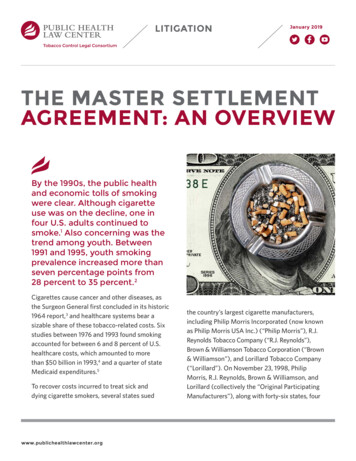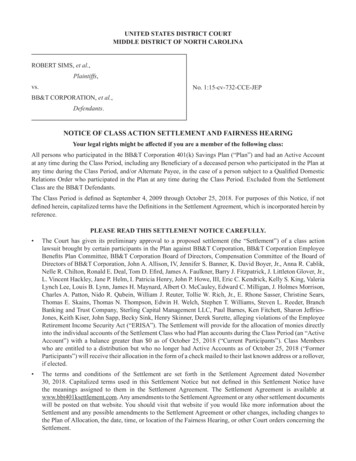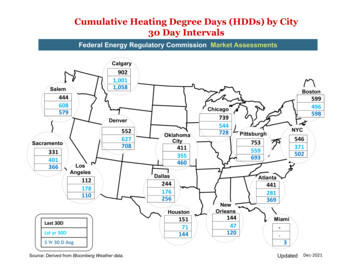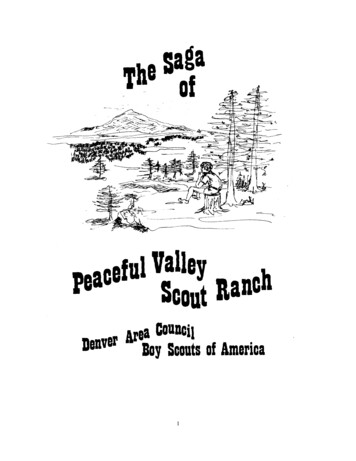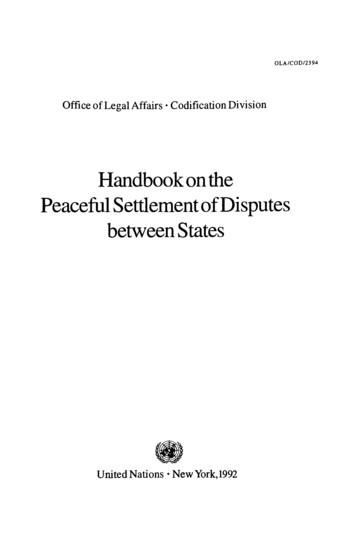
Transcription
OLA/COD/2394Office of Legal Affairs Codification DivisionHandbook on thePeaceful Settlement of Disputesbetween StatesUnited Nations New York, 1992
NOTESymbols of United Nations documents are composed of capital letterscombined with figures. Mention of such a symbol indicates a reference to aUnited Nations document.OLA/COD/2394UNITED NATIONS PUBLICATIONSales No. E.92.V.7ISBN 92-1-133428-4Copyright United Nations 1992All rights reservedManufactured in the United States of America
LE OF THE PEACEFUL SETTLEMENT OF DISPUTESBETWEEN STATES .Page1.A. Charter of the United Nations .B. Declarations and resolutions of the GeneralA ssem bly .C. Corollary and related principles .D. Free choice of means .1-2013323-1819-20347MEANS OF 100212474-8283-8687-9899-10024272932A.Negotiations and consultations .1. M ain characteristics .2. Initial phase .3. Conduct of the negotiating process .(a) Framework of the negotiating process(b) Place of negotiations .(c) Degree of publicity of the proceedings(d) Duration of the negotiation process .(e) Attitude of the parties .(f) Steps aimed at facilitating the negotiating process through the involvementof a third party .(g) Question whether the existence of an ongoing negotiation process precludes resort to another peaceful settlementprocedure .4. Outcome of the negotiations and possiblesubsequent steps .B. Inquiry .1. Functions and relation to other peaceful meansunder the Charter of the United Nations .2. Initiation and methods of work .3. Composition and other institutional aspects4. Outcome of the process .
ChapterC . Good offices .1. Main characteristics, legal framework andrelation to other peaceful means under theCharter of the United Nations .2. Functions .3. Application of the method .4. Institutional and related aspects .(a) Initiation of the procedure .(b) Methods of work and venue .5. Termination and outcome of the process .D . M ediation .1. Main characteristics and legal framework2. Functions .3. Procedural and institutional aspects .4. Outcome of the process .E. Conciliation .1. Main characteristics, legal framework andrelation to other peaceful means under theCharter of the United Nations .2. Functions .3. Application of the method .4. Institutional and related aspects .(a) Composition .(b) Initiation of the process .(c) Rules of procedure and methods of work(d) Duration and termination .(e) Expenses and other financial arrangements(f) Venue and secretariat of the commission5. Termination and outcome of the process .F. A rbitration .1. Main characteristics and legal framework2. Institutional and related aspects .(a) Types of arbitration agreements.(b) Composition .(c) Rules of procedure .(d) Applicable law .(e) Methods of work and proceedings beforethe tribunal 73174-191174-177178-179180181-182183-18662
ChapterParagraphsSeat and administrative aspects of anarbitral tribunal .(g) Expenses of an arbitral tribunal .3. Outcome of arbitration and related issues .G . Judicial settlem ent .1. Main characteristics, legal framework andfunctions .2. Resort to judicial settlement .3. Institutional and procedural aspects .(a) Jurisdiction, competence and initiationof the process .(b) Access and third-party intervention .(c) Com position .(d) Rules of procedure .(e) Seat and administrative aspects .(f) Expenses and other financial arrangem ents .4. Outcome of judicial settlement .H. Resort to regional agencies or arrangements .1. Main characteristics, legal framework and relation to other means of peaceful settlementprovided for by Article 33 of the Charter of theU nited N ations .2. Institutional arrangements, competence andprocedure .(a) League of Arab States .(b) Organization of American States .(c) Organization of African Unity .(d) European Convention for the PeacefulSettlement of Disputes (Council ofE urope) .(e) Conference on Security and Cooperationin Europe .(f') European and inter-American systemsfor the protection of human rights .(g) African Charter on Human and Peoples'R ights .(h) European Communities .(i) Economic Community of West -25486255-25887259-26288263264-267268
ChapterAgreements on shared managementof resources .3. Actual resort to regional agencies or arrangements in dispute settlement .(a) League of Arab States .(b) Organization of American States .(c) Organization of African Unity .(d) European Convention for the PeacefulSettlement of Disputes (Council ofE urope) .between regional agencies or arRelations4.rangements and the United Nations in the fieldof the peaceful settlement of local disputesOther peaceful means .1. Main characteristics and legal framework2. Resort to other peaceful means .(a) Novel means which do not consist in theadaptation or combination of familiarm eans .(b) Adaptations of familiar means .(c) Combination of two or more familiarmeans in the work of a single organ .ParagraphsPage269-27191(j)1.III.PROCEDURES 88-312288289-312290-295296-30599101306-312106IN THE CHARTER OF THEUNITED NATIONS .A . Introduction .B. The Security Council .1. Role of the Security Council in the peacefulsettlement of disputes .(a) Investigation of disputes and determination as to whether a situation is infact likely to endanger internationalpeace and security .(b) Recommendation to States parties to adispute to settle their disputes bypeaceful means .(c) Relation to procedures under regionalagencies or arrangements .2. Recent trends .C. The General Assembly .1. Role of the General Assembly in the peacefulsettlement of disputes 14333-335336-351352-366352-362123
Chapter(a) Discussion of questions and making recommendations on matters relating to thepeaceful settlement of disputes .(b) Recommendation of measures for thepeaceful adjustment of situations2. Recent trends .D . The Secretariat .1. Role of the Secretary-General .(a) Functions of the Secretary-General in theimplementation of the resolutions ofother principal organs in the field of theprevention or settlement of disputes .(b) Diplomatic functions .(c) Functions of the Secretary-Generalbased on the powers expressly conferredupon him by the Charter .2. Recent trends .V.PROCEDURES ENVISAGED IN OTHER INTERNATIONALINSTRUM ENTS .A . Introduction .B. Procedures envisaged in the constituent instruments of international organizations of a universalcharacter other than the United Nations .1. Procedures envisaged in economic and financial organizations .2. Procedures envisaged in the constitutions ofother international organizations with specialized activities .C. Procedures envisaged in multilateral treatiescreating no permanent institutions .1. Conventions containing optional proceduresfor dispute settlement .2. Conventions containing non-compulsoryand compulsory procedures in which boththe International Court of Justice and anarbitral tribunal are established as choicesfor judicial settlement .3. Conventions in which resort to the International Court of Justice is the only compulsoryjudicial settlement procedure .4. Conventions in which arbitration is the onlycompulsory procedure for judicial 8-430146419-421147422148423-424149425150
ChapterParagraphs5.6.7.Conventions in which conciliation is the onlythird-party compulsory procedure .Conventions combining adjudication andconciliation as compulsory procedures .Conventions which rely on panels of expertsfor resolving technical disputes .426151427-429151430152ANNEXESI. Charter of the United Nations .II. Statute of the International Court of Justice .III. Rules of the International Court of Justice of 14 April 1978BIBLIOGRAPHY .Page.IN D EX . . . . . . . . . . . . . . . . . . . . . . . . . . .
INTRODUCTIONBy its resolutions 39/79 and 39/88 of 13 December 1984, the GeneralAssembly requested the Secretary-General to prepare, on the basis of theoutline elaborated by the Special Committee on the Charter of the UnitedNations and on the Strengthening of the Role of the Organization and in thelight of the views expressed in the course of the discussions in the SixthCommittee and in the Special Committee, a draft handbook on the peacefulsettlement of disputes between States.In accordance with the conclusions reached by the Special Committee atits 1984 session with respect to the preparation of the draft handbook, theSecretary-General was instructed to consult periodically a representativegroup of competent individuals from among the members of the PermanentMissions of the States Members of the United Nations in order to obtainassistance in the performance of his task.' At the 1985 session, it was agreedthat the "representative group of competent individuals from among themembers of the Permanent Missions of the States Members of the UnitedNations" would be open to all members of the Special Committee and thatthe group would have purely consultative functions.'The Secretary-General accordingly consulted the above-mentioned representative group in preparing the various chapters of the handbook. Thehandbook in its final form was approved by the Special Committee at its1991 session.The purpose of the handbook is to contribute to the peaceful settlementof disputes between States and to help to increase compliance with international law by providing States parties to a dispute, particularly those Stateswhich do not have the benefit of long-established and experienced legaldepartments, with the information they might need to select and apply procedures best suited to the settlement of particular disputes.The handbook has been prepared in strict conformity with the Charter ofthe United Nations. It is descriptive in nature and is not a legal instrument.Although drawn up on consultation with Member States, it does not representthe views of Member States.In conformity with the above-mentioned resolutions, the scope of thehandbook was to be limited to disputes between States, excluding thosedisputes which although involving States fell under municipal law or werewithin the competence of domestic courts. However, at the request of the'Official Records of the General Assembly, Thirty-ninth Session, Supplement No. 33(A/39/33),para. 133 (a) (2).2Ibid., FortiethSession, Supplement No. 33 (A/40/33), para. 58 (a) and (c).
Consultative Group to the Secretary-General, 3 the draft handbook now includes disputes to which subjects of law other than States may be parties.The completion of this Handbook was generally recognized as a concreteand useful contribution to the United Nations Decade of International Law.3A/AC. 182/L.61, para. 6.
I.PRINCIPLE OF THE PEACEFUL SETTLEMENT OFDISPUTES BETWEEN STATESA.Charter of the United Nations1. The Charter of the United Nations provides in its Chapter I (Purposes and principles) that the Purposes of the United Nations are:"To maintain international peace and security, and to that end: to takeeffective collective measures for the prevention and removal of threatsto the peace, and for the suppression of acts of aggression or otherbreaches of the peace, and to bring about by peaceful means, and inconformity with the principles of justice and international law, adjustment or settlement of international disputes or situations which mightlead to a breach of the peace." (Article 1, paragraph 1)The Charter also provides in the same Chapter that the Organization and itsMembers, in pursuit of the Purposes stated in Article 1, shall act in accordance with, among others, the following principle: "All Members shall settletheir international disputes by peaceful means in such a manner that international peace and security, and justice, are not endangered" (Article 2,paragraph 3). It furthermore, in Chapter VI (Pacific settlement of disputes), states that:"The parties to any dispute, the continuance of which is likely to endanger the maintenance of international peace and security, shall, first of all,seek a solution by negotiation, enquiry, mediation, conciliation, arbitration, judicial settlement, resort to regional agencies or arrangements, orother peaceful means of their own choice." (Article 33, paragraph 1)B.Declarations and resolutions of the General Assembly2. The principle of the peaceful settlement of disputes has been reaffirmed in a number of General Assembly resolutions, including resolutions2627 (XXV) of 24 October 1970,2734 (XXV) of 16 December 1970 and 40/9of 8 November 1985. It is dealt with comprehensively in the Declaration onPrinciples of International Law concerning Friendly Relations and Cooperation among States in accordance with the Charter of the United Nations(resolution 2625 (XXV), annex), in the section entitled "The principle thatStates shall settle their international disputes by peaceful means in such amanner that international peace and security and justice are not endangered",as well as in the Manila Declaration on the Peaceful Settlement of International Disputes (resolution 37/10, annex), in the Declaration on the Prevention and Removal of Disputes and Situations Which May ThreatenInternational Peace and Security and on the Role of the United Nations in thisfield (resolution 43/51, annex) and in the Declaration on Fact-finding by the
United Nations in the Field of the Maintenance of International Peace andSecurity (resolution 46/59, annex).C.Corollary and related principles3. The principle of the peaceful settlement of international disputes islinked to various other principles of international law. It may be recalled inthis connection that under the Declaration on Friendly Relations, the principles dealt with in the Declaration-namely, the principle that States shallrefrain in their international relations from the threat or use of force againstthe territorial integrity or political independence of any State, or in any othermanner inconsistent with the purposes of the United Nations; the principlethat States shall settle their international disputes by peaceful means in sucha manner that international peace and security and justice are not endangered;the principle concerning the duty not to intervene in matters within the domestic jurisdiction of any State, in accordance with the Charter; the duty ofStates to cooperate with one another in accordance with the Charter; theprinciple of equal rights and self-determination of peoples; the principle ofsovereign equality of States; and the principle that States shall fulfil in goodfaith the obligations assumed by them in accordance with the Charter-areinterrelated in their interpretation and application and each principle shouldbe construed in the context of other principles.4. The Final Act of the Conference on Security and Cooperation inEurope, adopted at Helsinki on 1 August 1975, states that all the principlesset forth in the Declaration on Principles Guiding Relations between Participating States-i.e., Sovereign equality, respect for the rights inherent in sovereignty; refraining from the threat or use of force; inviolability of frontiers;territorial integrity of States; peaceful settlement of disputes; non-intervention in internal affairs; respect for human rights and fundamental freedoms,including the freedom of thought, conscience, religion or belief; equal rightsand self-determination of peoples; cooperation among States; and fulfilmentin good faith of obligations under international law-" are of primary significance and, accordingly, they will be equally and unreservedly applied, each ofthem being interpreted taking into account the others."5. The links between the principle of the peaceful settlement ofdisputes and other specific principles of international law are highlightedboth in the Friendly Relations Declaration and in the Manila Declaration,as follows:1. Principle of non-use offorce in internationalrelations6. The interrelation between this principle and the principle of thepeaceful settlement of disputes is highlighted in the fourth preambular paragraph of the Manila Declaration and is also referred to in section I, paragraph13, thereof, under which neither the existence of a dispute nor the failure ofa procedure of peaceful settlement of disputes shall permit the use of force orthreat of force by any of the States parties to the dispute.7. The links between the principle of peaceful settlement of disputesand the principle of non-use of force are also highlighted in a number of other
international instruments, including the 1945 Pact of the League of ArabStates (art. 5), the 1948 American Treaty on Pacific Settlement (Pact ofBogota) (art. I), the 1947 Inter-American Treaty of Reciprocal Assistance(arts. 1 and 2) and the last paragraph of section II of the Declaration onPrinciples Guiding Relations between Participating States contained in theFinal Act of the Conference on Security and Cooperation in Europe.2.Principleof non-intervention in the internalor external affairs of States8. The interrelation between this principle and the principle of thepeaceful settlement of disputes is highlighted in the fifth preambular paragraph of the Manila Declaration.9. The links between the principle of peaceful settlement of disputesand the principle of non-intervention are also highlighted in article V of the1948 Pact of Bogota.3.Principleof equal rights and self-determination ofpeoples10. The links between this principle and the principle of peaceful settlement of disputes are highlighted in the Manila Declaration which (1) reaffirms in its eighth preambular paragraph the principle of equal rights andself-determination as enshrined in the Charter and referred to in the FriendlyRelations Declaration and in other relevant resolutions of the General Assembly; (2) stresses in its ninth preambular paragraph the need for all States todesist from any forcible action which deprives peoples, particularly peoplesunder colonial and racist regimes or other forms of alien domination, of theirinalienable right to self-determination, freedom and independence; (3) refersin section I, paragraph 12, to the possibility for parties to a dispute to haverecourse to the procedures mentioned in the Declaration "in order to facilitatethe exercise by the peoples concerned of the right to self-determination"; and(4) declares in its penultimate paragraph that "nothing in the present Declaration could in any way prejudice the right to self-determination, freedom andindependence, as derived from the Charter, of peoples forcibly deprived ofthat right and referred to in the Declaration on Principles of International Lawconcerning Friendly Relations and Cooperation among States in accordancewith the Charter of the United Nations, particularly peoples under colonial orracist regimes or other forms of alien domination; nor the right of thesepeoples to struggle to that end and to seek and receive support, in accordancewith the principles of the Charter and in conformity with the above-mentioned Declaration".4.Principleof the sovereign equality of States11. The links between this principle and the principle of the peacefulsettlement of disputes are highlighted in the fifth paragraph of the relevantsection of the Friendly Relations Declaration which provides that "International disputes shall be settled on the basis of the sovereign equality ofStates" as well as in section I, paragraph 3, of the Manila Declaration.
5.Principlesof internationallaw concerning the sovereignty,independence and territorialintegrity of States12. Paragraph 4 of section I of the Manila Declaration enunciates theduty of States parties to a dispute to continue to observe in their mutual relationstheir obligations under the fundamental principles of international law concerning the sovereignty, independence and territorial integrity of States.6. Goodfaith in internationalrelations13. The Manila Declaration enunciates in its section I, paragraph 1, theduty of States to "act in good faith", with a view to avoiding disputes amongthemselves likely to affect friendly relations among States. Other referencesto good faith are to be found in paragraph 5, under which good faith and aspirit of cooperation are to guide States in their search for an early andequitable settlement of their disputes; in paragraph 11, which provides thatStates shall in accordance with international law implement in good faith allthe provisions of agreements concluded by them for the settlement of theirdisputes; in paragraph 2 of section II, under which Member States shall fulfilin good faith the obligations assumed by them in accordance with the Charterof the United Nations; and in one of the concluding paragraphs of the Declaration, whereby the General Assembly urges all States to observe and promotein good faith the provisions of the Declaration in the peaceful settlement oftheir international disputes.14. A provision similar to paragraph 5 of section I of the Manila Declaration is to be found in the third paragraph of section V of the Declarationon Principles Guiding Relations between Participating States contained in theFinal Act of the Conference on Security and Cooperation in Europe.7. Principlesofjustice and internationallaw15. The "principles of international law" are mentioned together withthe principles of justice in Article 1, paragraph 1, of the Charter under whichone of the purposes of the United Nations is "to bring about, by peacefulmeans, and in conformity with the principlesofjustice and internationallaw,adjustment or settlement of international disputes or situations which mightlead to a breach of the peace". (emphasis added) The principles of international law are also mentioned jointly with the principles of justice in sectionI, paragraph 3, of the Manila Declaration under which "international disputesshall be settled on the basis of the sovereign equality of States and in accordance with the principle of free choice of means in conformity with obligationsunder the Charter of the United Nations and with the principles ofjustice andinternationallaw." (emphasis added)16. Paragraph 4 of section I of the Manila Declaration provides that"States parties to a dispute shall continue to observe in their mutual relations.generally recognized principles and rules of contemporary internationallaw." (emphasis added)17. "Justice" is referred to in Article 2, paragraph 3, of the Charter andin the first paragraph of the relevant section of the Friendly Relations Declaration, both of which provide for the settlement of international disputes "by
peaceful means in such a manner that international peace and security andjustice are not endangered." (emphasis added)8. Other corollary and relatedprinciplesand rules18. In its tenth preambular paragraph, the Manila Declaration singles outamong "respective principles and rules concerning the peaceful settlement of international disputes", "the exhaustion of local remedies whenever applicable". Article VII of the 1948 Pact of Bogoti contains a similarprovision.D.Free choice of means19. The principle of free choice of means is laid down in Article 33,paragraph 1, of the Charter of the United Nations and reiterated in the fifthparagraph of the relevant section of the Friendly Relations Declaration and insection I, paragraphs 3 and 10, of the Manila Declaration. As indicated above,both the Friendly Relations Declaration and the Manila Declaration make itclear that recourse to, or acceptance of, a settlement procedure freely agreedto with regard to existing or future disputes shall not be regarded as incompatible with the sovereign equality of States. The principle of free choice ofmeans has also found expression in a number of other international instruments, including the Pact of Bogota (art. III) and the Declaration onPrinciples Guiding Relations between Participating States, contained inthe Final Act of the Conference on Security and Cooperation in Europe(third para. of sect. V).20. The following means are listed in Article 33 of the Charter, in thesecond paragraph of the relevant section of the Friendly Relations Declarationand in paragraph 5 of section I of the Manila Declaration: negotiation, inquiry, mediation, conciliation, arbitration, judicial settlement, resort to regional arrangements or agencies or other peaceful means of the parties' ownchoice. Among those "other peaceful means", the Manila Declaration singlesout good offices. Under the Friendly Relations Declaration (second paragraph of the relevant section) and the Manila Declaration (para. 5 of sect. I),it is for the parties to agree on such peaceful means as may be appropriate tothe circumstances and the nature of their dispute.
II. MEANS OF SETTLEMENTA.Negotiations and consultations21. Referring to negotiation, the International Court of Justice remarked that "there is no need to insist upon the fundamental character of thismethod of settlement". I It observed in this connection, 2 as did its predecessor,the Permanent Court of International Justice,3 that, unlike other means of settlement, negotiation which leads to "the direct and friendly settlement of . disputesbetween parties" is universally accepted. Furthermore, negotiations are usually a prerequisite to resort to other means of peaceful settlement of disputes.This was recognized as far as arbitral or judicial proceedings were concernedby the Permanent Court in the following words: "Before a dispute can bemade the subject of an action at law, its subject matter should have beenclearly defined by diplomatic negotiations." 4, It should be noted that theterm "diplomacy" is used in some treaties, such as the 1949 Revised GeneralAct for the Pacific Settlement of International Disputes, as a synonym of "negotiations", as is also the phrase "through the usual diplomatic channels" as itappears, for instance, in the 1948 Charter of the Organization of AmericanStates.1. Main characteristicsNegotiations22. The Manila Declaration on the Peaceful Settlement of InternationalDisputes highlights flexibility as one of the characteristics of direct negotiations as a means of peaceful settlement of disputes (sect. I, para. 10). Negotiation is a flexible means of peaceful settlement of disputes in severalrespects. It can be applied to all kinds of disputes, whether political, legal ortechnical. Because, unlike the other means listed in Article 33 of the Charter,it involves only the States parties to the dispute, those States can monitor allthe phases of the process from its initiation to its conclusion and conduct it inthe way they deem most appropriate.ILC.J Reports 1969, p. 48, para. 86.21n its judgment in the North Sea Continental Shelf case, ibid.31n its Order of 19 April 1929 in the case of the Free Zones of Upper Savoy and the Districtof Gex4 (PC.LJ., Series A, No. 22, p. 13).PC.J.J., Series A, No. 2, p. 15.5The question of the place which negotiation occupies among other means of peacefulsettlement of disputes was discussed, inter alia, in the framework of the United Nations SpecialCommittee on Principles of International Law Concerning Friendly Relations and Cooperationamong States. For a summary of the arguments advanced on this question within the SpecialCommittee, see Official Records of the General Assembly, Twentieth Session, Annexes, agendaitems 90 and 94, document A/5746, paras. 156, 158 and 161-163 and ibid., Twenty-first Session,Annexes, agenda item 87, document A/6230, paras. 195-206.
23. Another characteristic of negotiation highlighted by the ManilaDeclaration is effectiveness (sect. I, para. 10). Suffi
(f) Expenses and other financial arrange-m ents . . 4. Outcome of judicial settlement . H. Resort to regional agencies or arrangements . 1. Main characteristics, legal framework and re-lation to other means of peaceful settlement provided for by Article 33 of the Charter of the
